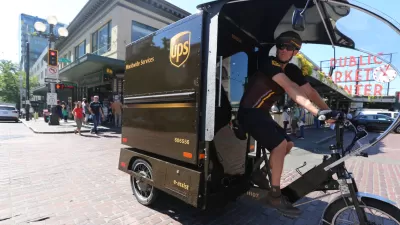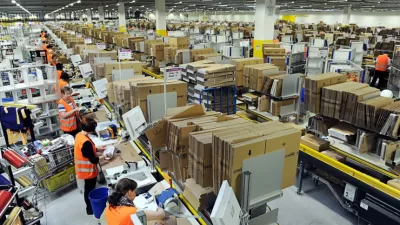Services like Amazon Prime and other quick delivery online retailers are creating more demand for short trip delivery, the result is streets jammed with vans. Bikes may offer an alternative.

According to Alexa, a website tracking company owned by Nielsen, Amazon.com generates the eighth most traffic of any website in the world, and according to a Quartz article by Benjamin Rieder, they may generate a high volume of the world’s road traffic as well. "Just a few years ago, delivery in urban centers was about dropping off large volumes of goods at shops. Today, it’s about delivering small numbers of parcels to different addresses, often directly to consumers," Rieder writes. This change in how people get goods means more small trips within cities and more cars on the road. "Many consumers now expect their parcels to be shipped on the day they place the order and, if possible, delivered to within a very specific timeslot," Rieder explains.
Cities trying to adjust to this traffic trend are attempting to mitigate the congestion caused by online retailers. "There is a push to “internalize the net external costs” of deliveries," Rieder writes. This push involves things like low-emissions zones where trucks are banned and strict time slots for delivery vehicles.
Rieder argues that bike delivery services, like Bubble Post, which he co-founded, can ameliorate this problem, saying, "Not only can bicycles deliver packages more quickly than delivery trucks by bypassing traffic gridlocks, they’re also more energy efficient." He goes on to point out that bike delivery is growing in parts of Europe: "DHL Express, a large shipping company in the Netherlands, said at the ECLF conference that it wanted to replace 10% of its fleet with bikes, and that 65% of its urban routes would be delivered by bikes."
FULL STORY: Our Amazon addiction is clogging up our cities—and bikes might be the best solution

Alabama: Trump Terminates Settlements for Black Communities Harmed By Raw Sewage
Trump deemed the landmark civil rights agreement “illegal DEI and environmental justice policy.”

Planetizen Federal Action Tracker
A weekly monitor of how Trump’s orders and actions are impacting planners and planning in America.

Why Should We Subsidize Public Transportation?
Many public transit agencies face financial stress due to rising costs, declining fare revenue, and declining subsidies. Transit advocates must provide a strong business case for increasing public transit funding.

Understanding Road Diets
An explainer from Momentum highlights the advantages of reducing vehicle lanes in favor of more bike, transit, and pedestrian infrastructure.

New California Law Regulates Warehouse Pollution
A new law tightens building and emissions regulations for large distribution warehouses to mitigate air pollution and traffic in surrounding communities.

Phoenix Announces Opening Date for Light Rail Extension
The South Central extension will connect South Phoenix to downtown and other major hubs starting on June 7.
Urban Design for Planners 1: Software Tools
This six-course series explores essential urban design concepts using open source software and equips planners with the tools they need to participate fully in the urban design process.
Planning for Universal Design
Learn the tools for implementing Universal Design in planning regulations.
Caltrans
Smith Gee Studio
Institute for Housing and Urban Development Studies (IHS)
City of Grandview
Harvard GSD Executive Education
Toledo-Lucas County Plan Commissions
Salt Lake City
NYU Wagner Graduate School of Public Service





























